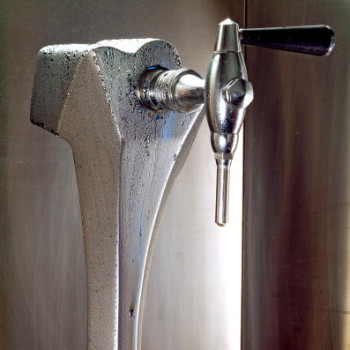There’s a curious drink trend creeping across the land: pre-made or ‘draft’ cocktails. Some consider it strange, even sacrilege. To others, it’s a matter of convenience – think Manhattans on demand. Rico chats with Jeremy Adler and Kiowa Bryan of L.A.’s Eveleigh – which is offering negroni cocktails on tap – about the pros and cons of mass-produced cocktails.

Rico Gagliano: I start with the obvious question: Why draft cocktails?
Jeremy Adler: Why? Well, it’s a busy Saturday night. You’re going to have the bar three deep, and a drink takes three to four minutes to make. How do you make a beautiful drink a little bit faster?
Rico Gagliano: That’s interesting that you’re admitting straight up that it’s simply for convenience but the whole kind of craft cocktail movement has been about waiting 20 minutes for the perfect freshly squeezed lime thing. Are we seeing that maybe peeking? Is this the end of that?
Kiowa Bryan: Well, you don’t have to sacrifice quality at the convenience of making a drink a little bit faster. It’s still top of the line.
Jeremy Adler: Actually, what’s cool about this is that you would think that the next day something would change. The flavor would become muddled or muddy. I think it tastes better after a few days. It allows those flavors to come together. When you make a braise, the braise always tastes better the next day.
Rico Gagliano: So it’s like a pasta sauce? Seriously? Like a cocktail improves in the keg?
Jeremy Adler: I think the flavors marry together under pressure without oxygen and fuse together into one flavor.
Rico Gagliano: Yeah, but this again though, I have to say that kind of puts the why to this idea of you want your cocktail as fresh as possible. Is it just a different product or is it better?
Jeremy Adler: I think it’s better. There’s a lot of preconceived notions about ‘freshness’ like sushi is always better that day. Some fish taste better two or three days later.
There’s this notion that you need to have something fresh, but sometimes time is important. It’s important for fermentation.It’s important for braises. And I think, this cocktail, it’s also important for this one too.
Rico Gagliano: By the way, why did you pick a negroni specifically to be the one that you keg?
Kiowa Bryan: It’s every bartender’s classic favorite drink and blood oranges were in season when we put it on draft and blood oranges in a negroni are just a match made in heaven, so it just seemed to make sense.
Rico Gagliano: For those who don’t know, what’s in a negroni?
Kiowa Bryan: It is a classic cocktail with gin, Campari, and sweet vermouth.
Rico Gagliano: Why is that the bartender’s favorite?
Kiowa Bryan: Campari. The bitterness to it is just a bartenders best friend.
Rico Gagliano: Why is that? Just because it so instantly transforms other flavors?
Kiowa Bryan: I don’t know. Bartenders just have a… I feel like our palettes love that bitter element.
Rico Gagliano: It does have sort of a grown up flavor to it. It’s not like a mudslide, for sure.
Kiowa Bryan: Yes. When I was 21 and I tasted Campari for the first time I thought it was terrible and an old man’s drink, but now that’s the only thing that’s in my cabinet. Campari and sweet vermouth and every other spirit so that I can make any variation on a negroni I want.
Rico Gagliano: What is the process for preparing this as opposed to say mixing it one at a time?
Kiowa Bryan: We make it by adding a shrub to it and a shrub keeps for a long period of time.
Rico Gagliano: A shrub, of course, is fermented vinegar sugar kind of confection that’s put in the cocktails to make them sweet and sour. Does that actually help the drink be kegged?
Kiowa Bryan: Sugar and vinegar act as a natural preservative so if you were to use a fresh fruit juice in a keg cocktail it wouldn’t stay fresh as long or actually originally a shrub was created to preserve fruit longer.
Also it has this nice sweet and sour component. The acid that’s in the vinegar just compliments that bitterness of the drink really nicely.
Rico Gagliano: It’s like nature’s BHT, isn’t it?
Kiowa Bryan: Absolutely. Yeah, it’s the most natural preservative – vinegar and sugar.
Rico Gagliano: How long actually will it preserve the cocktail? How long will it last in the keg without losing flavor?
Kiowa Bryan: Probably it could go about two weeks, but it’s been so popular that we’ve been going through five gallons every four to five days.
Rico Gagliano: Can I try this thing?
Jeremy Adler: Definitely.
Rico Gagliano: It looks like a beer tap here although albeit a very nice stainless steel one. It’s weird because I’ve never seen something bright red come out of a bar tap before.
Kiowa Bryan:
Guests are always confused. They think it’s just beer coming out and they see something bright red.Then it’s just like the mystique of “What is coming out of that tap?” and then everyone wants to try it. It’s one of those things like you see… A guest sees one getting poured and then everybody in the room wants to try it.
Rico Gagliano: It’s a little bit vampire-y which makes it part of the zeitgeist right now.
Kiowa Bryan: Absolutely.
Rico Gagliano: You weren’t inspired by “Twilight” were you?
Kiowa Bryan: I’m not going to answer that question.
Rico Gagliano: I’m going to sip this thing. Oh, and you’ve got a nice slice of blood orange in it as well. Here we go.
That is lovely!
Jeremy Adler: We want it to be carbonated. Right now it’s frizzante.
Rico Gagliano: That’s a great word. What does that mean?
Jeremy Adler: It’s Italian for ‘just a little bubble.’
Rico Gagliano: Just a tiny bubble?
Jeremy Adler: Yeah. Frizzante!
Rico Gagliano: I love that. It’s a beautiful word for something that didn’t quite happen.
Jeremy Adler: Well, you know, it still tastes good.


